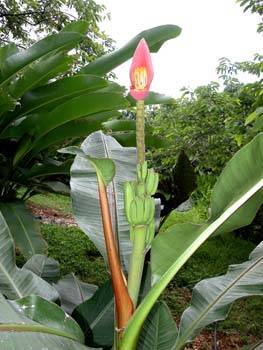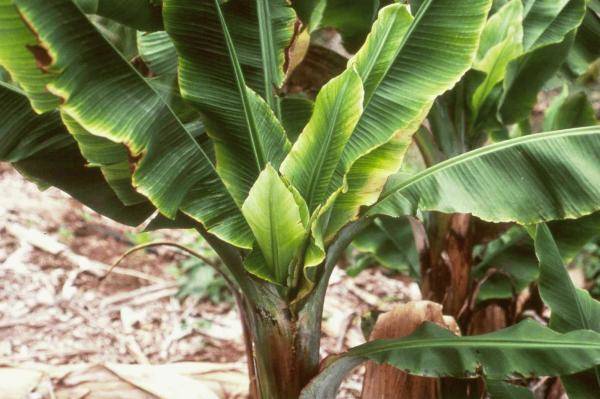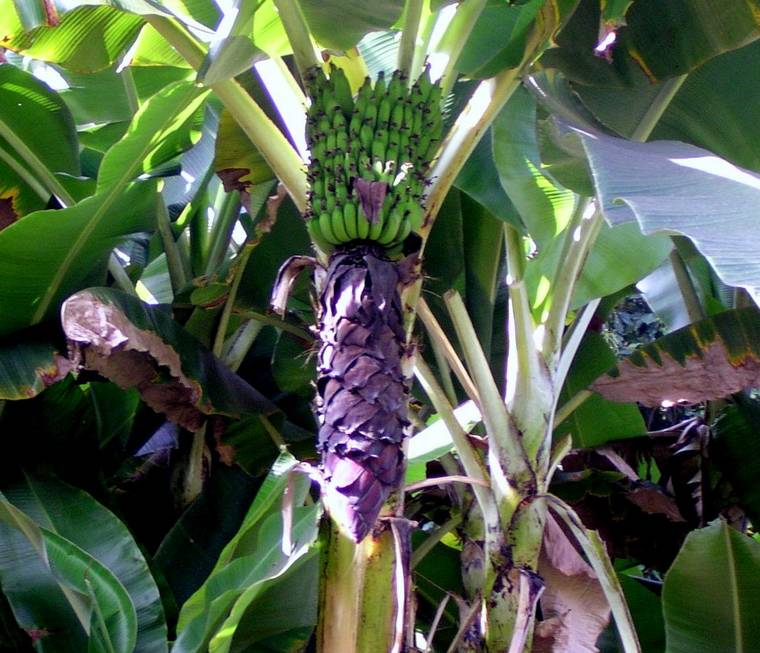Plant of the Month for November – bananas

The ornamental banana Musa ornata is an interesting but not edible banana variety. (Photo courtesy / Ken Love)


Dwarf Brazilian bananas often produce a long stalk covered with spent flowers. (Photo courtesy / Diana Duff )
My ongoing interest in encouraging people to grow edible plants leads me to reiterate the multiple ornamental, cultural and edible uses of the lovely banana. The plants can enhance the appearance of a tropical garden, have many useful benefits and offer delicious fruit as a bonus. Since the plants are easy to grow in most Kona locations, property owners might want to consider growing one or more banana varieties.
My ongoing interest in encouraging people to grow edible plants leads me to reiterate the multiple ornamental, cultural and edible uses of the lovely banana. The plants can enhance the appearance of a tropical garden, have many useful benefits and offer delicious fruit as a bonus. Since the plants are easy to grow in most Kona locations, property owners might want to consider growing one or more banana varieties.
Bananas are in the Musaceae family. The cultivars that are popular in Hawaii are in the Musa genus and are members of either the acuminata or balbisiana species or a cross of the two.
Research indicates that descendants of today’s bananas first grew in Malaysia around 2000 B.C. Buddhist texts described banana plants as early as 600 B.C and Alexander the Great’s army found bananas in India around 300 B.C. Alexander is credited with bringing bananas to the west. The botanical name Musa was likely a reference to Antonius Musa, who was the doctor for the Roman emperor Octavius Augustus. Musa was known to be cultivating bananas in Italy as early as 63 B.C.
Recent historical research reveals that banana plantations existed in China as early as 200 A.D. Bananas were reportedly brought to Africa about 500 years later and eventually made it to the Americas and the Caribbean Islands. Today wild varieties of M. acuminata grow in wetter areas of northeastern India, Southeast Asia and Indonesia while domesticated cultivars are grown worldwide as a commercially important sweet banana.
M. acuminate cultivars including lady finger as well as Williams, bluefields and several Chinese or cavendish are grown today in Hawaii. The dwarf cavendish, which has worldwide popularity, arrived in Hawaii around 1855 and has become very popular here.
Centuries ago, the M. balbisiana species crossed with M. acuminate, probably with the help of humans, in the Indo-Malaysian region producing some banana cultivars that grow here today. Perhaps the most popular is the apple banana, which arrived in Hawaii from China in 1868. Other cultivars in this species that are grown in Kona include Brazilian, common plantain and ice cream bananas.
Smaller tropical gardens may want to grow the Musa ornata or flowering banana. It is smaller in size and produces a showy flower in shades of purplish pink or deep yellow-orange. The fruit, which is not edible, grows upright.
Banana plants are not actually trees but are herbaceous monocots that have an internal vascular structure that, in cross section, appears to be layers of undeveloped leaves. Their structure is similar to other monocots like palms, bamboo, corn or many grasses.
Though we may refer to banana plants as trees and their stalks as a trunk, their stalks contain gallons of water. Their structural make up as well as their rapid growth rate makes them ideal candidates for a sound barrier. Grown in groups, they are literally a wall of water and can provide a visual barrier as well. They can also provide some welcome shade in a sunny garden.
Fresh bananas have many culinary uses in addition to eating them out of hand. Check the internet for recipes or dry or freeze them for later use.
Culturally, banana leaves are often used to wrap food for cooking or to use as serving platters. They can also be used to cover a table or decorate a surface. The trunks are often used in underground ovens called imu to cook food for a feast or luau. When cut, the water in them provides steam that aids in the cooking process.
Bananas are usually propagated by division. A mature banana plant will put out “suckers” from its rhizomatous root or corm. Those that produce narrow sword like leaves will produce the best yield. Water suckers with wider leaves will be less productive. Once a sucker is between 18- and 24-inches high, it is ready to be separated from the mother and planted out.
Bananas grow best in moist soil with a pH range between 5.5 and 7.5 that drains well. They prefer areas that get rainfall between 60 and 100 inches annually. At upper elevations with afternoon cloud cover they can be planted in full sun. Though they can tolerate the hot sun at lower elevations, planting them in an area that has partial shade will help maintain the moist soil they prefer. And while they can grow from sea level to 3,000 feet in elevation, they can suffer from salt spray and high winds and these conditions should be avoided.
Banana leaves are large and dark green. They can be over 6-feet long in some cultivars. They have a tough central vertical rib and lots of horizontal veins. Planting bananas where they will have good wind protection will keep the leaves looking healthy. Their softness and veination make them especially susceptible to wind damage that can actually shred them and mar their appearance.
In ideal conditions, bananas will grow rapidly and produce a flower stalk from the center that droops toward the ground. Multiple bananas appear on the stalks once the flowers are pollinated. Once the individual fruits fill out fully and at least one turns yellow, they are ready to harvest.
All banana plants bear only one stalk of fruit before they die. Prior to fruiting, they will put out suckers for the next generation. As they grow and produce suckers over time, mats will develop and should be maintained at five or six plants for best production.
Banana plants reach fruit bearing age in a year to a year and a half, depending on the cultivar. They are heavy feeders so planting them in rich soil, fertilizing two to three times a year with 10-5-20 (or comparable) fertilizer and mulching the roots will help them thrive and produce well. Since the plants contain a high potassium level, chopping up the trunk and using it for mulch will add potassium to the soil.
The dwarf cavendish is one of the smallest plants; usually less than 10-feet tall. Williams and bluefields can reach 25-feet high and produce larger bunches. Each of these cultivars produce fruit that ranges from 6-8-inches long.
Apple banana plants are medium in size reaching 15-feet tall in some cases. They produce small, plump fruit about 5-inches long. Brazilian bananas are larger in size and grow from plants that can reach 25-feet in height. The common plantain and ice cream bananas grow on tall trees and produce fruit from 7-10-inches long. Though most bananas ripen to a full yellow color, the ice cream cultivar ripens to a pale yellow with a slight bluish cast.
Though many pests including scale, aphids, mealy bugs, whitefly and thrips can attack banana plants all can be controlled by keeping plants healthy and by spraying with low toxicity formulas of soap and oil (usually Safer soap and neem oil). Bananas occasionally get fungal and bacterial diseases but these can usually be prevented by maintaining healthy plants in soil that drains well.
Monitor your bananas often to enable harvest as soon as the fruit is ripe. As they ripen, bananas may attract rats, chickens or other birds who will eat them if they are left in place.
Though most of these issues do not threaten the life of the plant, the viral disease banana bunchy top is fatal. Spread by aphids from infected plants, the disease will kill the plant. Once detected, infected plants should be immediately removed from the site. Detection information is available online.
Web information on bananas abounds. Type bananas into your search engine and you’ll find information on nutritional and medicinal benefits as well as recipes and more growing and harvesting tips.
Bananas are a pleasure to grow, regardless of the variety you choose. Just be sure to include at least one stand of bananas in your garden. They will grace you with an attractive plant, some shade and lots of healthy fruit.
Traditional Trees of Pacific Islands edited by Craig R. Elevitch was a primary source for this article. The “Musa” chapter that is full of information about bananas was a collaboration of Scot Nelson, Randy Ploetz and Angela Kepler.
Diana Duff is a plant adviser, educator and consultant living part time in Kailua-Kona.
Gardening Events
Saturday: “Work Day at Amy Greenwell Garden” from 9 a.m. to noon. Meet at the Garden Visitor Center across from the Manago Hotel in Captain Cook. Volunteers will be able to help with garden maintenance and are invited to bring a brown bag lunch. Water and snacks provided. Call Peter at 323-3318 for more information.
“Friends of Amy B. H. Greenwell Ethnobotanical Garden Annual Membership Meeting” starting at 1 p.m. in the Garden in Captain Cook. Come to catch up happenings in the past year and to hear about future plans. The Friends are in the process of purchasing the Garden from Bishop Museum. Garden tours start at 11 a.m. Morning workers, tour takers and friends are invited to bring a picnic lunch. Following the brief business meeting, new members for the board of directors will be elected and Friends president Maile Melrose will speak about the Garden. Everyone is invited to attend and celebrate our progress. Call Maile Melrose at 323-3378 for more information.
Farmer Direct Markets
Wednesday: “Hooulu Farmers Market” 9 a.m. to 2 p.m. at Sheraton Kona Resort &Spa at Keauhou Bay
Saturday: “Keauhou Farmers Market” 8 a.m. to noon at Keauhou Shopping Center
“Kamuela Farmer’s Market” from 7:30 a.m. to 1 p.m. at Pukalani Stables
“Waimea Town Market” from 7:30 a.m. to noon at the Parker School in central Waimea
“Waimea Homestead Farmers Market” from 7 a.m. to noon next to Thelma Parker Gym in front of Thelma Parker Library.
Sunday: “Pure Kona Green Market” 9 a.m. to 2 p.m. at Amy Greenwell Garden in Captain Cook
“Hamakua Harvest” 9 a.m. to 2 p.m. at Highway 19 and Mamane Street in Honokaa
Plant Advice Lines
Anytime: konamg@ctahr.hawaii.edu
Tuesdays &Thursdays: 9 a.m. to noon at UH-CES in Kainaliu – 322-4892
Mon., Tues. &Fri: 9 a.m. to noon at UH CES at Komohana in Hilo 981-5199 or himga@hawaii.edu


